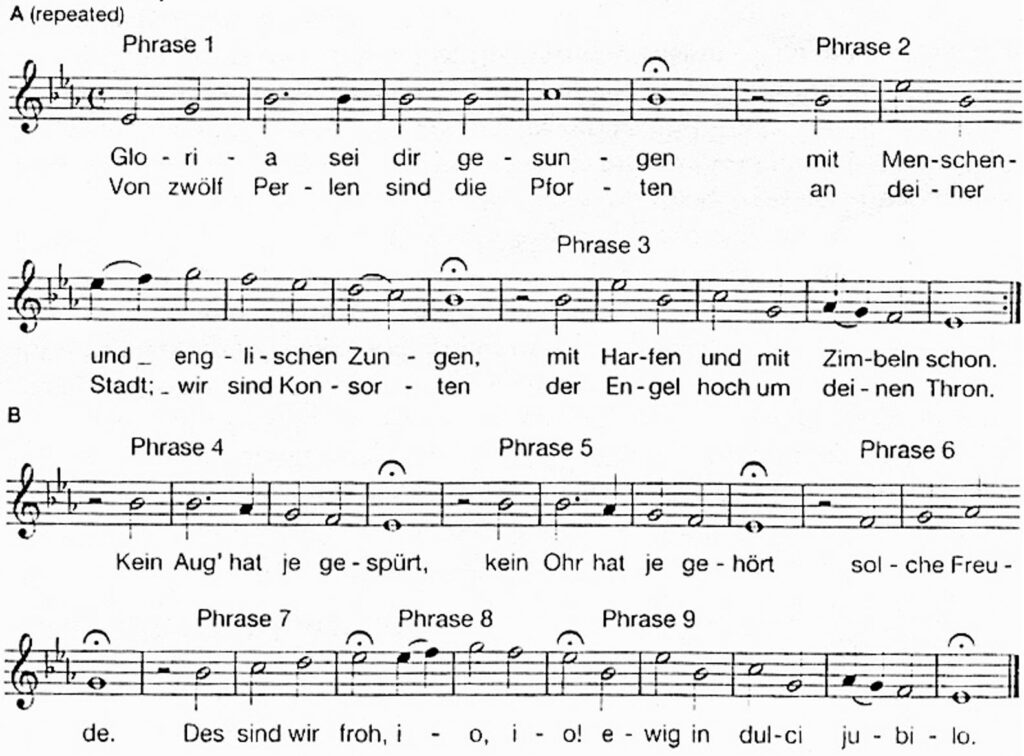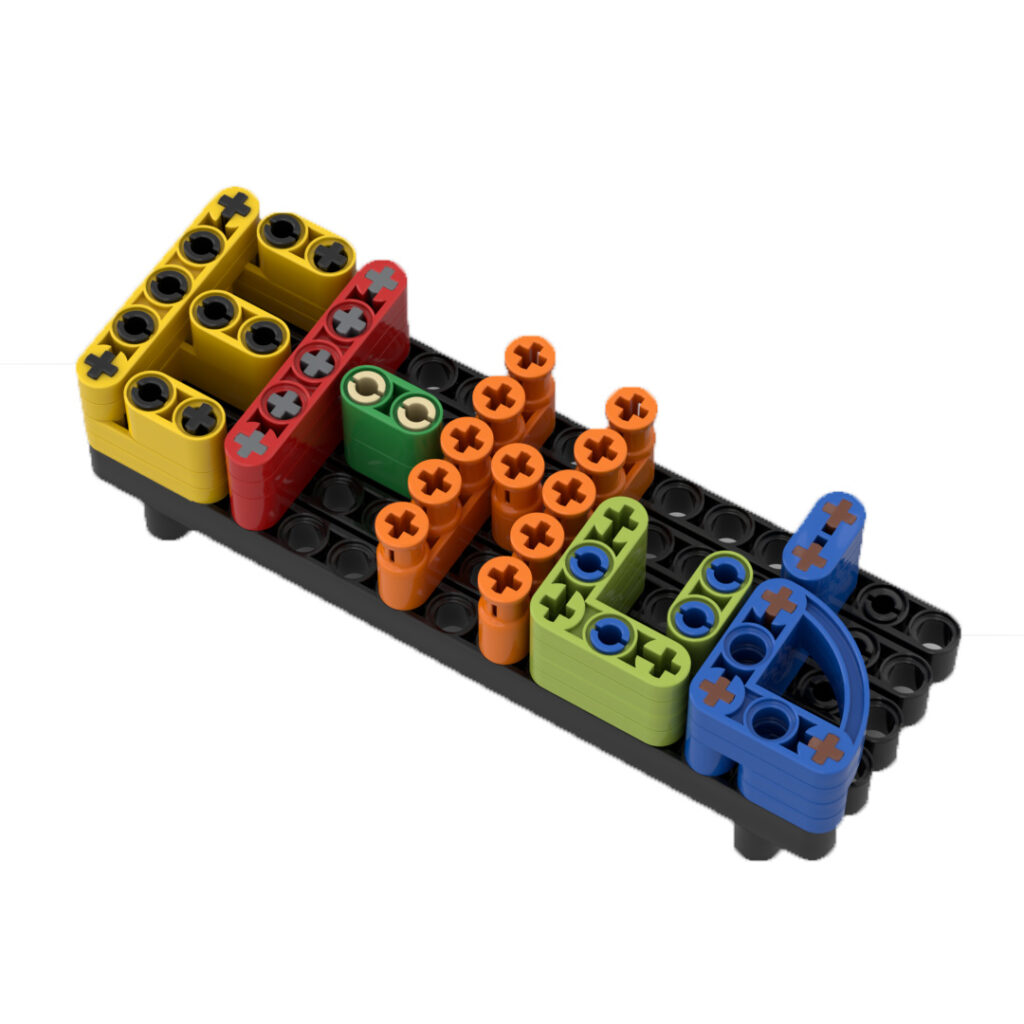清唱劇 Cantata
巴赫:第一百四十清唱劇「醒來吧!」
J.S. Bach: Cantata No.140, Wachet auf
Cantata (清唱劇)一字來自意大利文 cantare (歌唱),指演唱的樂曲,與 sonata (演奏的樂曲) 相對。清唱劇是一種聲樂套曲,風格和歌劇相似,帶有宣敍調(recitative)和詠嘆調(aria),亦分獨唱(solo)、重唱(ensemble)、合唱(chorus)等,亦由樂隊伴奏,但只供宗教儀式或音樂會演出使用,沒有佈景、服裝和動作。它和神劇(oratorio)亦很相似,但篇幅較短。
清唱劇的分類有多種。
一:教堂清唱劇(church cantata)為內容和聖經有關的清唱劇。
二:世俗清唱劇(secular cantata)為內容和聖經無關的清唱劇。
三:獨唱清唱劇(solo cantata)為只運用了獨唱者和樂隊的清唱劇。
四:合唱清唱劇(choral cantata)為運用了合唱團的清唱劇。
五:眾讚歌清唱劇(chorale cantata)為運用了眾讚歌的清唱劇(眾讚歌為路德教派的一種讚美詩歌,類似現在的聖詩)。巴赫第一百四十清唱劇「醒來吧!」既是教堂清唱劇,亦是合唱和眾讚歌清唱劇。
此清唱劇作於1731年,用於三一節後第27個禮拜日演唱。這一天的福音書(馬太福音第25章第1-13節)講述十個童女拿著燈去迎接新郎,五個聰明的帶備燈油,五個愚蠢的卻沒有。愚蠢的童女後來去買油,這時新郎來了,和準備好了的童女一同參加婚筵。待愚蠢的童女到來時門已關上。
這首作品共分七個樂章,全曲結構工整平衡:
第一、四、七樂章運用了尼古拉(Philip Nicholai)一首眾讚歌(圖例),由合唱團演出。
第二、三樂章組成一組,
第五、六樂章又組成一組,兩組皆為宣敍調加詠嘆調的組合。

Cantata
- Cantata originally meant a piece to be sung, as distinct from a sonata, which was to be played.
- It is a new genre in the Baroque period, consists of several movements including recitatives[1], arias[2], and ensemble numbers.
- It is a work for solo vocalists, chorus, and instrumentalists based on a lyric or dramatic poem.
- Unlike oratorios, it can be sacred (religious) or secular (non-religious).
- Church cantatas are designed for the Lutheran church service in Germany in the early 1700s. The cantata text was related to them. Every Sunday of church year required its own cantata. With extra works for holidays and special occasions, an annual cycle came to about 60 cantatas.
- They are written for the church congregation but not intended for public concert.
[1] A type of vocal writing, which follows the natural rhythms and accentuation of speech and its pitch contours. It is a vehicle for dialogue and a connecting link between arias.
[2] A term for a song either independent or part of a larger work. It had a central place in early opera, cantata and oratorio.
J.S. Bach (1685-1750)
- Bach composed over 1000 works. From 1946 to 1950, Dr. Wolfgang Schmieder compiled a numerical listing of Bach’s opus in BWV number[3] (Bach Werk Verzeichnis) according to genres.
- He worked as court organist and concertmaster in Weimar from 1708 to 1717, music director at court of a prince in Cothen from 1717 to 1723 and Cantor of St. Thomas’s School, and music director in Leipzig from 1723 to 1750.
[3] BWV 1-224
BWV 225-231
BWV 232-243
BWV 244-249
BWV 250-438
BWV 439-524
BWV 525-771
BWV 772-994
Cantatas
Motets
Masses and Magnificat
Passions and Oratorios
Chorals
Songs and Arias
Organ Works
Keyboard Works
BWV 995-1000
BWV 1001-1040
BWV 1041-1065
BWV 1066-1071
BWV 1072-1078
BWV 1079
BWV 1080
Lute Works
Chamber Music
Concerti
Overtures, Sinfonies
Canons
Music Offering
The Art of Fugue
Bach’s Cantatas
- Bach wrote more than 300 cantatas during his life, most were composed in his early years in Leipzig. Between 1723 and 1729, Bach composed 4 complete annual cycles of cantatas (totally about 195 church cantatas). He also composed the 5th cycle, but many do not survive.
- Much of his cantata production is connected to the duties of church office or to the preparation of career steps in Leipzig, as churches required a lot of cantatas for Lutheran church services. He also wrote a few secular cantatas.
- Typically, a Bach cantata opens with a chorus based on a chorale melody (Lutheran hymns of the 16th or 17th century written by Martin Lurther), followed by some movements of recitatives, arias, and duets. It ends with a simple or embellished version of the same chorale.
第一樂章內容敍述看守的人喚醒信徒,迎接基督的來臨。這樂章運用了全樂隊和合唱團的所有聲部,以覆奏樂節曲式(ritornello form)寫成(即是一段樂隊引子不斷在樂章中重現)。這個覆奏樂節曲式運用了附點節奏,具有進行曲色彩,表示信徒迎接基督的來臨。在合唱部份,女高音以眾讚歌為固定主題(cantus firmus),其他聲部以節奏較快的音樂進行。
第二樂章為一首獨唱男高音的宣敍調。由於它只用了通奏低音(basso continuo)來伴奏,所以是一首「清宣敍調」(recitativo secco)。歌詞內容為宣佈新郎的即將來臨。這套清唱劇將信徒接受耶穌基督比喻為一個婚禮,因此新郎為耶穌基督,新娘為接受耶穌的靈魂。
第三樂章為一首二重唱的詠嘆調,由獨唱女高音和男低音唱出。人類的靈魂(女高音)表達對耶穌渴望之情,而耶穌(男低音)則表現慰藉之情。這樂章由高章小提琴奏出充滿裝飾的旋律。
第四樂章再次運用了尼古拉的眾讚歌。這樂章分三個聲部進行:合唱團的男高音、小提琴及中提琴齊奏的高音聲部、以及通奏低音(basso continuo)奏出的低音聲部。樂章首先由小提琴及中提琴奏出一個非常優美的新旋律,然後合唱團的男高音伴隨著這個旋律唱出眾讚歌,歌詞內容為基督的到來。
第五樂章是一首由獨唱男低音唱出的宣敍調,歌詞內容為基督對新娘的接納。這樂章除了通奏低音(basso continuo)外,還運用了樂隊(第一、第二小提琴和中提琴)伴奏,因此是一首「有伴奏宣敍調」(recitativo accompagnato)。
第六樂章又是一首二重唱的詠嘆調更獨唱女高音和男低音唱出。伴奏的樂器除了通奏低音(basso continuo)外,還運用了一支獨奏的雙簧管。這樂章歌詞的內容為結合的福氣。兩個獨唱時而以較短的樂句交替,時而在長的句子中結合,表達一種歡樂和滿足的情緒。這樂章的曲式為「返始詠嘆調」(da capo aria),意思即詠嘆調的第一部份在第二部份後重現,形成ABA的曲式。
第七樂章將眾讚歌以最簡單的四部和聲出現,由全樂隊及全合唱團演出,內容為感恩。
修訂自《音樂教室》頁63-64
Cantata BWV 140, Wachet auf, ruft uns die Stimme (1731)
(Wake up, Cries the Watchmen Voice)
概論 Introduction
- Cantata: written for the 27th Sunday after Trinity (one of the cantata cycles), actual performance at 25th 1731. (Because this Sunday only occurred in the church year when Easter was very early, the cantata was rarely performed.)
- Central theme: The Parable of the Wise and Foolish Virgins, and turns later to a description of heavenly Zion.
- Written at Leipzig in 1731.
- Instrumentation:
French horn, oboes I & II, oboe da caccia or taille [old style of cor anglais],
violino piccolo, violins I & II, viola, basso continuo, and 4-part (SATB)
Chorus with soprano, tenor and bass soloists.
- Librettists: Philipp Nicolai (Movements 1, 4 & 7), Anon. (Movements 2, 3, 5 & 6), based on the parable of the ten virgins in Matthew 25:1-13.
[新約聖經《馬太福音》廿五章1 – 13節 – 十個童女的比喻]
1「那時,天國好比十個童女拿著燈出去迎接新郎。
2其中有五個是愚拙的,五個是聰明的。
3愚拙的拿著燈,卻不預備油;
4聰明的拿著燈,又預備油在器皿裡。
5新郎遲延的時候,他們都打盹,睡著了。
6半夜有人喊著說:『新郎來了,你們出來迎接他!』
7那些童女就都起來收拾燈。
8愚拙的對聰明的說:『請分點油給我們,因為我們的燈要滅了。』
9聰明的回答說:『恐怕不夠你我用的;不如你們自己到賣油的那裡去買吧。』
10他們去買的時候,新郎到了。那預備好了的,同他進去坐席,門就關了。
11其餘的童女隨後也來了,說:『主啊,主啊,給我們開門!』
12他卻回答說:『我實在告訴你們,我不認識你們。』
13所以,你們要警醒;因為那日子,那時辰,你們不知道。」
- Melody: based on the chorale of the same name by Philipp Nicolai
結構 Structure
|
|
Movements |
Performers |
Accompaniment |
Key |
Meter |
Content of Text |
|
|
I |
Chorale: |
Chorus |
Full Orchestra |
Eb |
3/4 |
Virgins awakened by watchmen announcing the coming of the bridegroom. |
|
|
II |
(Secco) Recitative: |
Tenor |
Basso Continuo |
Cm |
4/4 |
The bridegroom is coming. |
|
|
III |
Aria (duet): |
Soprano |
Violino Piccolo |
Cm |
6/8 |
Dialogue between a longing soul (soprano) and Jesus (bass) |
|
|
IV |
Chorale: |
Chorus (Tenors only) |
Strings (unison) |
Eb |
4/4 |
Zion (Christian believers) rejoices at the arrival of Lord Jesus, God’s son. |
|
|
V |
(Accompagnato) Recitative: |
Bass |
Strings |
(Bb) |
4/4 |
Jesus lovingly greets the bride. |
|
|
VI |
Aria (duet): |
Soprano |
Oboe solo |
Bb |
4/4 |
Joyous union between Christ (bass) and Christian (soprano). |
|
|
VII |
Chorale: |
Chorus |
Full Orchestra |
Eb |
4/4 |
Christians praise God and rejoice in union with Him. |
|
清唱劇的分析 Analysis of the cantata
Chorale Tune “Wachet auf”

First Movement: Chorale Fantasia, Ritornello form
Wachet auf, ruft uns die Stimme
Wake up, the voice calls us
Der Wächter sehr hoch auf der Zinne,
of the watchmen high up on the battlements,
Wach auf, du Stadt Jerusalem!
wake up, you city of Jerusalem!
Mitternacht heißt diese Stunde;
This hour is called midnight;
Sie rufen uns mit hellem Munde:
they call us with a clear voice:
Wo seid ihr klugen Jungfrauen?
where are you, wise virgins ?
Wohl auf, der Bräutgam kömmt;
Get up, the bridegroom comes;
Steht auf, die Lampen nehmt! Alleluja!
Stand up, take your lamps! Hallelujah!
Macht euch bereit Zu der Hochzeit,
Make yourselves ready for the wedding,
Ihr müsset ihm entgegen gehn!
you must go to meet him!
- The movements opens with an orchestral ritornello that may have been intended to suggest a procession. (Indicated with dotted rhythms, a rising figure with syncopation and a series of rising scales)
- Sopranos sing the chorale tune and the other three voices sing in an imitative dialogue based on a new motive.
- There are three layers of sound:
1. The chorale tune (sopranos) Long notes
2. The imitative dialogue (other voices) Shorter notes
3. Busy accompaniment (orchestra) Motives from the ritornello
Second Movement: Recitative (Tenor solo)
Er kommt, er kommt,
He comes, he comes,
Der Bräutgam kommt!
the bridegroom comes!
Ihr Töchter Zions, kommt heraus,
You daughters of Zion, come out,
Sein Ausgang eilet aus der Höhe
he hastens his departure from on high
In euer Mutter Haus.
to your mother’s house.
Der Bräutgam kommt, der einem Rehe
The bridegroom comes, who like a roedeer
Und jungen Hirsche gleich
and a young stag
Auf denen Hügeln springt
leaps on the hills
Und euch das Mahl der Hochzeit bringt.
and brings to you the wedding feast.
Wacht auf, ermuntert euch!
Wake up, rouse yourselves
Den Bräutgam zu empfangen!
to welcome the bridegroom!
Dort, sehet, kommt er hergegangen.
There, see, he comes this way.
Third Movement: Aria (Soprano and Bass), Da capo aria
Soul:
Wenn kömmst du, mein Heil?
When are you coming, my salvation?
Jesus:
Ich komme, dein Teil.
I come, your portion.
Soul:
Ich warte mit brennendem Öle.
I wait with burning oil.
Jesus:
Eröffne den Saal
Open the hall
Soul:
Ich öffne den Saal
I open the hall
Both:
Zum himmlischen Mahl
to the heavenly feast.
Soul:
Komm, Jesu!
Come, Jesus!
Jesus:
Komm, liebliche Seele!
Come, lovely soul!
Fourth Movement: Tenor Chorale, Ritornello form
Zion hört die Wächter singen,
Zion hears the watchmen sing,
Das Herz tut ihr vor Freuden springen,
her heart leaps for joy,
Sie wachet und steht eilend auf.
she awakes and gets up in haste.
Ihr Freund kommt vom Himmel prächtig,
Her friend comes from heaven in his splendour,
Von Gnaden stark, von Wahrheit mächtig,
strong in mercy, mighty in truth.
Ihr Licht wird hell, ihr Stern geht auf.
Her light becomes bright, her star rises.
Nun komm, du werte Kron,
Now come, you worthy crown,
Herr Jesu, Gottes Sohn!
Lord Jesus, God’s son!
Hosianna!
Hosanna!
Wir folgen all
We all follow
Zum Freudensaal
to the hall of joy
Und halten mit das Abendmahl.
and share in the Lord’s supper.
- This is one of the most popular movement in Bach’s cantatas. Bach rearranged it as a chorale prelude for organ solo known as the first of six Schübler Chorale Preludes, BWV 645 – 650.
- Two contrasting melodies play against each other: The warm, flowing melody which is played by the strings union and the stable, slower chorale tune which is sung by the tenors.
Fifth Movement: Recitative (Bass solo)
So geh herein zu mir,
So come inside to me
Du mir erwählte Braut!
you bride that I have chosen for myself,
Ich habe mich mit dir
Von Ewigkeit vertraut.
I have betrothed mysef to you from eternity to eternity.
Dich will ich auf mein Herz,
It is you that I want to set in my heart,
Auf meinem Arm gleich wie ein Siegel setzen
on my arm like a seal
Und dein betrübtes Aug ergötzen.
and to delight your grieved eyes.
Vergiß, o Seele, nun Die Angst, den Schmerz,
Forget now, o soul, the anguish, the sorrow
Den du erdulden müssen;
that you had to suffer
Auf meiner Linken sollst du ruhn,
On my left hand you should rest
Und meine Rechte soll dich küssen.
and my right hand should kiss you.
Sixth Movement: Aria (Soprano and Bass), Da capo aria
Soul:
Mein Freund ist mein,
My friend is mine,
Jesus:
Und ich bin dein,
and I am yours,
Both:
Die Liebe soll nichts scheiden.
Nothing shall divide our love.
Soul:
Ich will mit dir in Himmels Rosen weiden,
I want to graze on heaven’s roses with you,
Jesus:
du sollst mit mir in Himmels Rosen weiden,
You will graze on heaven’s roses with me,
Both:
Da Freude die Fülle, da Wonne wird sein.
There will be fullness of joy, there will be delight.
Seventh Movement: Tenor Chorale, Ritornello form
Gloria sei dir gesungen
May gloria be sung to you
Mit Menschen- und englischen Zungen,
with the tongues of men and angels,
Mit Harfen und mit Zimbeln schon.
with harps and with cymbals.
Von zwölf Perlen sind die Pforten,
The gates are made of twelve pearls,
An deiner Stadt sind wir Konsorten
in your city we are companions
Der Engel hoch um deinen Thron.
of the angels on high around your throne.
Kein Aug hat je gespürt,
No eye has ever perceived,
Kein Ohr hat je gehört
no ear has ever heard
Solche Freude.
such joy.
Des sind wir froh,
Therefore we are joyful,
Io, io!
hurray, hurray!
Ewig in dulci jubilo.
for ever in sweet rejoicing.
- Here the chorale is set in a relatively simple, homophonic texture for four voices, with the instruments simply doubling them.
- No doubt the congregation joined in the singing of the final chorale, which so firmly expressed their ubity and belief.
